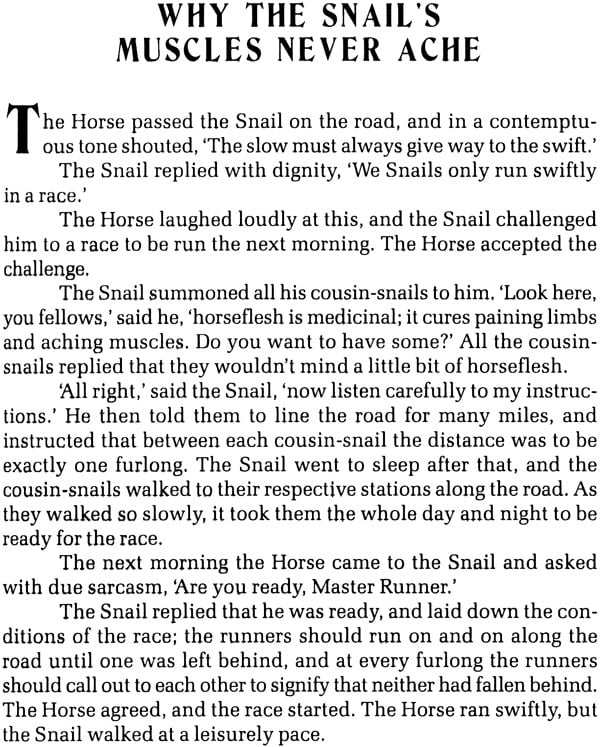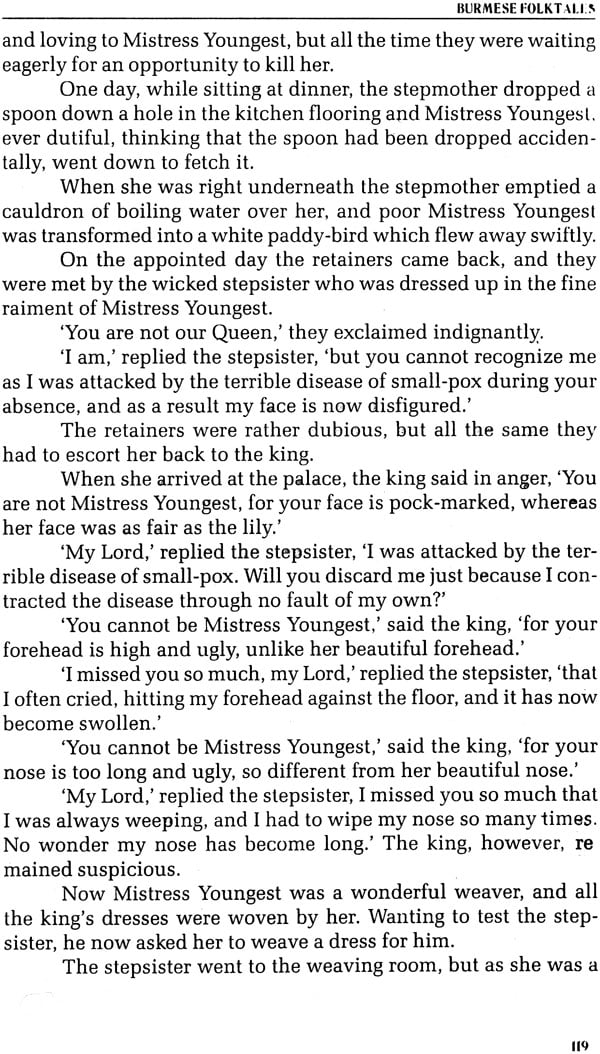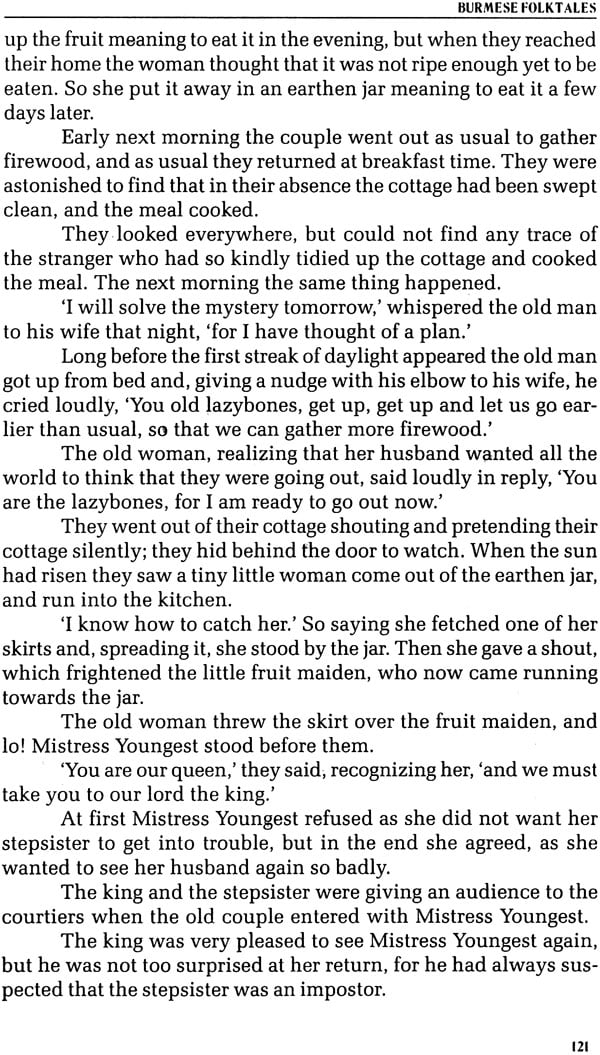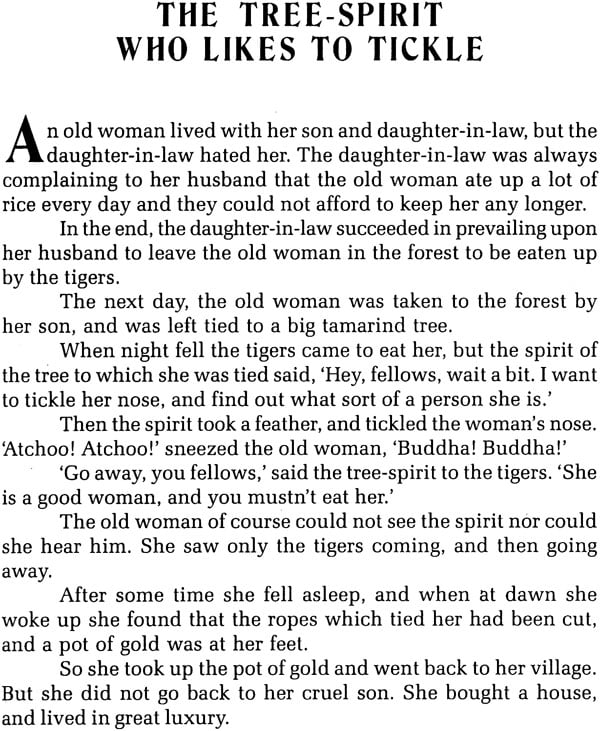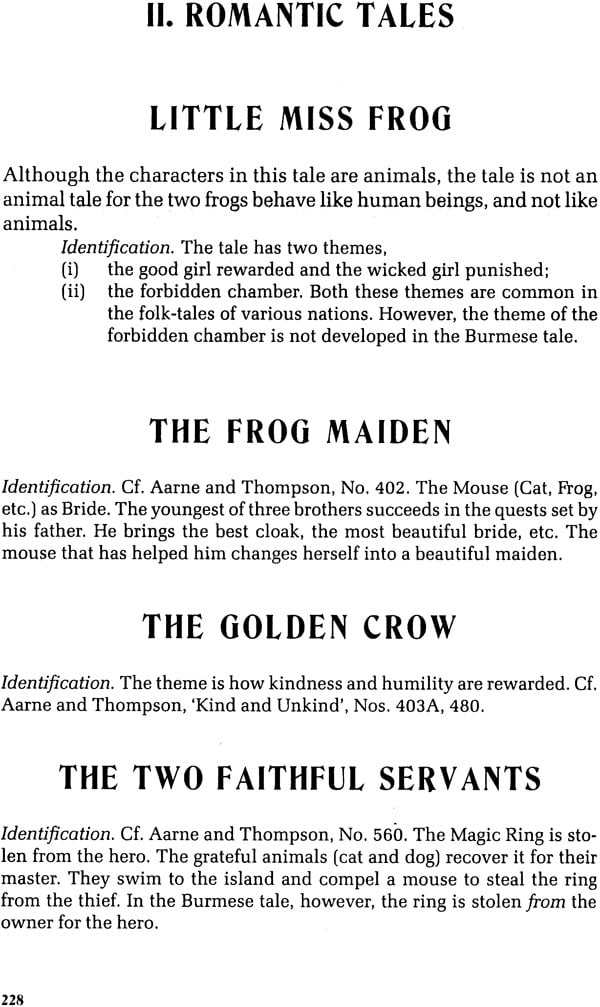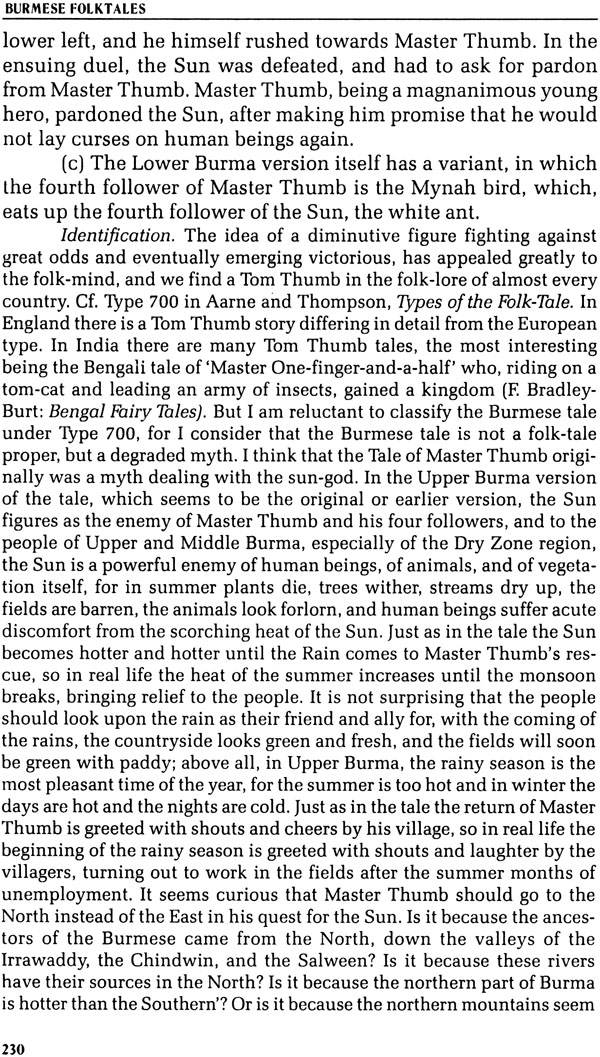
Burmese Folk-Tales
Book Specification
| Item Code: | IDJ049 |
| Author: | Htin Aung |
| Publisher: | Pilgrims Publishing Varanasi |
| Language: | English |
| Edition: | 2003 |
| ISBN: | 9788177691146 |
| Pages: | 237 |
| Cover: | Paperback |
| Other Details | 8.4" X 5.5" |
| Weight | 300 gm |
Book Description
About the Book:
The village story teller in Burma considered a tale and no more, and would not distinguish or classify the stories that he told. But actually tales told in Burmese villages could be divided into three categories
(i) Folk tales
(ii) Folk legends and
(iii) Jatakas or Buddhist birth tales.
This collection of Burmese folk tales is highly coloured and exotic. The stories illumine universal human truths. The atmosphere of these tales is of the same kind as their European counterparts. Some of the tales are highly significant in courts of low and often contain pointers as to how certain situations should be dealt with. They form the foundation of many decisions taken in courts of law.
The folk tales included in this collection were current in Upper Burma and, to a less extent, in Lower Burma also, until two or three decades ago. Most of them had their origin in Upper Burma, for until the destruction of the Mon Empire of Pegu by Alaungpaya in 1752, the home of the Burmese people was Upper Burma. In the last decade or two, with the advent of the fiction magazine, the novel, and the cinema, these village folk tales have come to be half- forgotten.
Tales told in the Burmese village could be divided into three categories, (i) folk tales, (ii) folk legends, and (iii) Jatakas, or Buddhist Birth stories.
But the village storyteller considered a tale as a tale and no more, and he would not distinguish or classify the stories that he told. For the folk tale collector then, there are many pitfalls: a tale which appears at first to be a perfect folk tale may prove to be a Jataka on careful scrutiny; like, for example, the account of the enmity between the Owl and the Crow (given below as Appendix I). And a tale, which appears to be a folk legend, may prove to be a folk tale after all, like, for example, the account of the prediction of the astrologer of Pagan.
Folk legends are of two classes, (i) those relating to persons who are either heroes or magicians mentioned in the chronicles, and (ii) those relating to places. In this second class are (a) place- name stories, like, for example, the legend of the Wild Boar of Tagaung, dealing with places on the eastern bank of the Irrawaddy, the names of which begin with Wet, the Burmese word for 'boar' (given below as Appendix 11); (b) stories about places, like, for ex- ample, the legend of the Indaw Lake (given below as Append ix Ill); and (c) stories relating to buried treasure. Most folk legends relating to persons and events before A.D. 1044 may originally have been folk tales, which were later incorporated in the chronicles.
Although some writing was known at least in palace circles in the Kingdom of Prome that flourished before Pagan, it was only after 1044 that the Burmese alphabet came into being. This was as a result of the conquest of the Mon Kingdom of Thaton by Anawrahta (King of Pagan 1044-1077). In consequence the history of Burma before 1044 is legendary, in the sense that it is not based on contemporary records. As the chronicles were written only after 1044, for events before 1044 the chroniclers had to rely on the tradition of the palace and legends of the people. In these circumstances, doubt- less a few folk tales crept into the chronicles as legends.
The account of King Outsider (given below as Appendix IV), for example, seems to be in reality a folktale, although it is to be found in the chronicles. That a monarch by the name of King Outsider once ruled over the Kingdom of Prome there is no reason to doubt, for the list of kings of Pro me as given in the chronicles is on the whole authentic. The chroniclers relied on palace tradition for that, and, as the names of the previous kings of Burma were always carefully handed down from generation to generation of palace officials, palace tradition was unlikely to err in its list of kings.
But what does the name 'King Outsider' signify? It merely signifies that a person who did not belong to the royal line became king. Therefore, it is not impossible that the folk tale relating to a person, who became a king just because he ate the head of a cock, was accepted as a traditional account of the real King Outsider of Prome. The theme of the story of King Outsider is not how a poor lad became king, but that the flesh of the cock had certain magical qualities which would accrue to its eater. Viewed in this light, the story of King Outsider is of the same category as the folk tale of the Gold Cock.
Perhaps a belief that the flesh of a cock had certain magical properties was prevalent in Burma and the neighbouring regions in primitive times. The less civilized peoples of Burma, especially the Karens and the Chins, use the legs of a cock for purposes of divination. In the folk-tale of the Astrologer of Pagan, there is an attempt to explain why the legs of a cock should be able to divine.
There is also e Jataka: in which the magical qualities of the flesh of a cock serve as the main theme. As a peasant was sleeping under a tree, he heard two cocks quarrelling; the first cock boasted that anyone eating his flesh would become the possessor of much gold and jewellery, and the second cock boasted that anyone eating his flesh would become king. The villager killed the second cock and cooked it, but as he was not fated to be king an accident intervened and, in the end, the king's prime minister ate the flesh of the cock and became king afterwards. It is perhaps interesting to re- member that Burma, with its numerous streamlets and wooded valleys, was one of the earliest homes, if not the original home, of the fowl.
In 1056 Buddhism became the state religion of the Kingdom of Pagan, which now included the whole of Burma in its dominions. Pagan became a great centre of Buddhism, and there was widespread study of the Buddhist scriptures by monks and scholars. The scriptures were in Pali, and had yet to be translated, but the villagers gradually became familiar with the Jatakas through the village monk, who would include one or two Jatakas in his sermon on the sabbath day. Many of the Jatakas are animal fables, and every Jataka contains some moral. The coming of the Jatakas to the village perhaps resulted in the disappearance of the folk fable or moral tale.
Among the folk tales in this collection, only one could be termed a fable, namely 'The Rabbit has a Cold'. But even there, the stress is laid on the wisdom of the Rabbit, the hero of the Burmese animal tales, rather than on any moral. The acceptance of Buddhism also meant the acceptance of Buddhist and semi-Buddhist mythology and, as a result, the native myths disappeared, except for a few which became degraded into folk tales. In this collection, 'The Eclipse of the Moon', 'The Old Man in the Moon' and 'The Three Dragon Eggs' are obviously myths degraded into folk tales and perhaps 'Master Thumb' is also a degraded myth.
In Burmese literature there are many tales, but they can be reduced into four groups, (i) Jataka tales, (ii) tales with some moral or religious background, adapted from Sanskrit and Pali sources, and (iii) Juristic tales.
But the classification is far from watertight; a proverbial tale may often be also a Jataka tale or an adapted Sanskrit tale, and many Juristic tales are adaptations from Sanskrit and Pali sources. Pali and Sanskrit were widely studied after 1056. A Burmese proverbial tale is not a fable. A fable points to some moral lesson, which can be expressed in the form of a proverb or saying, but a proverbial tale narrates the particular set of circumstances which gave rise to a proverb or a saying.
To make the difference clear, let us suppose that 'If you give him an inch, he will take a mile' was a Burmese saying. Now Aesop's tale of the camel, who first asked to be allowed to put his head in his master's tent and who in the end took possession of the whole tent, is a fable which will illustrate the above saying. But, a proverbial tale to illustrate the saying would narrate how one inch was actually given and how one mile was actually taken. There are approximately one thousand proverbial tales in Burmese literature. Some of them are Jatakas, like, for example, the tale of the saying, 'If one tries to rival one's teacher, one is hit with brickbats.' This narrates how the wicked pupil of a great harpist was hit with stones and brickbats by an irate mob as he insolently challenged his teacher to a musical contest and was duly defeated:" some of them are adaptations from Pali or Sanskrit sources, but most of them, I think, were originally folk tales, for surely most of the sayings originated from native tales. In this collection there are some folk tales which are also to be found among proverbial tales, although in different style and tone.
A Juristic tale illustrates a point of law or describes a clever decision of a judge. It has some official authority, for it could be cited by a disputant or his advocate before a court of law. A Juristic tale may be an adaptation from Sanskrit or Pall, or a modified folk tale, or a tale invented by the writer, or a record of an actual decision made by a judge in a court of law. There exist many collections of Juristic tales, and they were written or collected by judges or lawyers. Burmese Law, like English Common Law, was customary, and the Juristic Tales served as commentaries on the law.
They were meant to guide, not so much the trained and experienced lawyers and judges of the King's capital and the big towns, but the honorary justices of the villages and the small towns. The people themselves elected these honorary justices to decide civil disputes which were too petty to be taken to the King's courts. They were formally appointed by the King when the people had chosen them, and there was a right of appeal from the decision of an honorary justice to the King's courts. But that right was seldom exercised by the people, for a decision of their own judge was usually accepted as the correct interpretation of the law. In this collection there are a few tales, adaptations of which are also to be found among Juristic tales.
| INTRODUCTION | ix-xxiii | |
| I | ANIMALS TALES | 1 |
| WHY THE SNAIL'S MUSCLES NEVER ACHE | 3 | |
| WHY THE WREN IS SMALL | 5 | |
| THE COMING OF DAYWAW | 8 | |
| THE RABBIT HAS A COLD | 11 | |
| HOW THE RABBIT RID THE FOREST OF ITS TYRANT | 13 | |
| WHY THE TIGER AND THE MONKEY ARE SWORN ENEMIES | 15 | |
| MASTER PO AND THE TIGER | 18 | |
| JUDGE RABBIT | 21 | |
| HOW THE CROCODILE LOST HIS LONGUE | 23 | |
| THE THREE FOOLISH ANIMALS | 27 | |
| GOLDEN RABBIT AND GOLDEN TIGER | 29 | |
| WHY THE RABBIT NOSE TWITCHES | 32 | |
| THE OVER-CUNNING RABBIT | 34 | |
| WHY THE TIGER IS SO BITTER AGAINST THE CAT | 36 | |
| WHY THE CORMORANT HAS NO TAIL | 38 | |
| THE PUFFER FISH AND THE GRASSHOPPER | 40 | |
| THE CROW AND THE WREN | 42 | |
| WHY THE CROW LOOKS AFTER THE CUCKOO'S EGGS | 46 | |
| HOW THE CROW'S LEG BECAME A PLANT | 49 | |
| HOW FRIENDSHIP BEGAN AMONG BIRDS | 51 | |
| HOW THE CROW BECAME SMALL IN SIZE | 53 | |
| WHY THE QUAIL STANDS ON ONE LEG | 55 | |
| WHY THE VULTURE IS BALD | 57 | |
| A BRIDEGROOM FOR MISS FROG | 58 | |
| THE LITTLE CHICKEN AND THE OLD CAT | 60 | |
| HOW THE BATS ESCAPED PAYING TAXES | 62 | |
| HOW THE GALON BIRD BECAME A SALT-MAKER | 64 | |
| WHY THE BUFFALO HAS NO UPPER TEETH | 66 | |
| WHY THE BARKING DEER BARKS | 68 | |
| II | ROMANTIC TALES | 71 |
| LITTLE MISS FROG | 73 | |
| THE FROG MAIDEN | 76 | |
| THE WONDERFUL COCK | 80 | |
| THE GOLDEN CROW | 82 | |
| THE FIVE COMPANION | 85 | |
| THE TWO FAITHFUL SERVANTS | 87 | |
| MAUNG PAUK KYAING | 90 | |
| MASTER THUMB | 95 | |
| THE DIMINUTIVE FLUTE PLAYER | 99 | |
| GOLDEN TORTOISE | 102 | |
| MASTER HEAD | 106 | |
| THE BIG EGG | 109 | |
| MISTER LUCK AND MISTER INDUSTRY | 112 | |
| THE BIG TORTOISE | 115 | |
| THE SNAKE PRINCE | 124 | |
| THE TRAGIC ENDING | 127 | |
| THE HAPPY ENDING | 129 | |
| RAIN CLOUND THE CROCODILE | 134 | |
| THE RAINBOW | 137 | |
| THE OLDMAN IN THE MOON | 140 | |
| THE ECLIPSE OF THE MOON | 142 | |
| THE THREE DRAGON EGGS | 145 | |
| III | WONDER TALES | 147 |
| WHY THERE ARE SO MANY PAGODAS AT PAGAN | 149 | |
| THE PINCERS OF PAGAN | 153 | |
| THE FORTUNE-TELLER OF PAGAN | 155 | |
| IV | THE HUMOROUS TALE | 159 |
| THE ORIGIN OF THE COCONUT | 161 | |
| THE GREAT KING EATS CHAFF | 164 | |
| THE DRUNKARD AND THE OPIUM-EATER | 166 | |
| THE OPIUM - EATER AND THE FOUR OGRES | 169 | |
| THE DRUNKARD AND THE WRESTLING GHOST | 171 | |
| THE TREE-SPIRIT WHO LIKES TO TICKLE | 173 | |
| THE THIEVES AND THE POT OF GOLD | 175 | |
| THE FOOLISH BOY | 177 | |
| THE FOUR FOOLISH MEN | 179 | |
| THE FOUR MIGHTY MEN | 184 | |
| THE FOUR YOUNG MEN | 186 | |
| THE FOUR DEAF PEOPLE | 190 | |
| THE FOUR DEAF MAN | 192 | |
| MASTER CROOKED AND MASTER TWISTED | 194 | |
| CROOKED MASTER Z | 198 | |
| THE BOAT-MASTER AND THE BOATMAN | 204 | |
| THE BOAT-MASTER AND THE MAN FROM HILLS | 207 | |
| THE MUSICIAN OF PAGAN | 211 | |
| APPENDIX | 213 | |
| APPENDIX I. THE ORIGIN OF THE ENMITY BETWEEN THE OWL AND THE CROW | 213 | |
| APPENDIX II. THE WILD BOAR OF TAGAUNG | 214 | |
| APPENDIX III. THE LEGEND OF INDAW LAKE | 217 | |
| APPENDIX IV. KING OUTSIDER | 219 | |
| NOTES | 220 | |
| ANIMAL TALES | 220 | |
| ROMANTIC TALES | 228 | |
| WONDER TALES | 236 | |
| HUMENROUS TALES | 237 |
